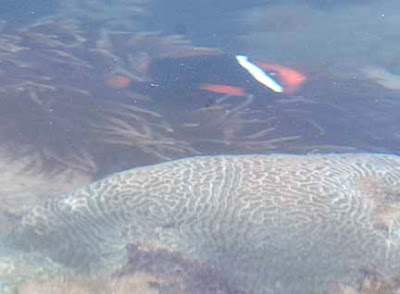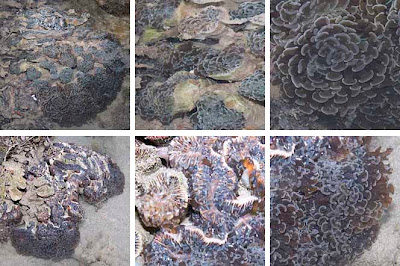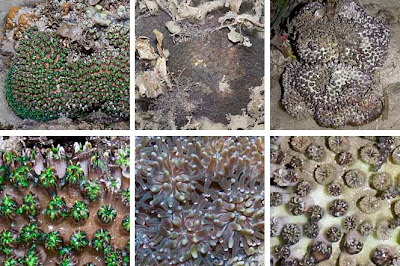We last visited this shore nearly a year ago, at the height of the coral bleaching event. Have the corals here survived?
Terumbu Semakau is a submerged reef that lies just off the Semakau Landfill and some parts of the original Pulau Semakau.
 We arrive just before dawn, so the petrochemical plants on Pulau Bukom were still brightly lit.
We arrive just before dawn, so the petrochemical plants on Pulau Bukom were still brightly lit.I head straight for the rich reefy edge of this shore that faces Pulau Semakau.
The shore looks a lot better than when I visited last year during the coral bleaching event. More about coral bleaching on Bleach Watch Singapore.
 Today, in some parts, I saw corals still growing densely next to one another.
Today, in some parts, I saw corals still growing densely next to one another.The reef edge here is very rich in some parts!
There are many nice large corals on the reef edge.
A pair of large squids are hanging on the water surface, while lots of colourful reef fish swim about in the rather clear water.
A large Tomato anemonefish (Amphiprion frenatus) is frolicking in the water!
A Magnificent anemone (Heteractis magnifica) near some Pebble coral (Astreopora sp.).
This stretch of reef is very close to the landfill, the seawall on the horizon.
This stretch of reefs extends to lie opposite reefs on Pulau Semakau itself. On Pulau Semaku, there are mangroves, the short, same-height mangroves have been replanted when the landfill was built, while the ones further behind are the original mangroves on Pulau Semakau.
Lots of mangrove leaves and propagules are washed up on the reef. Reefs and mangroves are part of a natural continuum on the shores and they are good for one another.
The Cauliflower corals (Pocillopora sp.) were very badly affected during coral bleaching. I did see many colonies that seemed alright, but also some that were still very white.
Some of the corals are half dead. The living parts are still white and clean, while the dead portions are very quickly covered with scum. So it's hard to tell which corals died during the coral bleaching event.
Here's a closer look at the dead and live portions of the hard coral.
I saw a few Acropora corals (Acropora sp.) and Montipora corals (Montipora sp.) which were not bleaching.
I also saw several plate Montipora corals (Montipora sp.).
I was delighted to see several healthy Euphyllid corals (Family Euphyllidae) as these corals were badly affected during coral bleaching.
It was nice to see several Pebble corals (Astreopora sp.) and a large healthy Trumpet coral (Caulastrea sp.).
As usual, the most common hard coral are Favid corals (Family Faviidae). Most were alright. I saw a few that seemed rather excessively luminiscent, and some with dead portions.
More Favid corals with a maze-like pattern.
I came across a small cluster of Tongue mushrooom corals (Herpolitha sp.).
How nice to see many colonies of Galaxy coral (Galaxea sp.). Most were doing fine, although a few showed signs of ill-health.
The Anemone corals (Goniopora sp.) were badly affected during coral bleaching, so it was good to see many healthy colonies today.
Ridged plate coral (Merulina sp.) are not so common, so it was nice to see several of them in good health.
There were also several large healthy Brain corals (Family Mussidae), although some were an odd colour. These corals were badly affected during the coral bleaching event.
I saw one Carnation coral (Pectinia sp.) and even one small colony of Horned coral (Hydnophora sp.).
There were also some disk corals (Turbinaria sp.) of all kinds. Most seemed alright.
All the leathery soft corals (Family Alcyoniidae) I saw were not bleaching. I saw many of the common varieties of these corals.
There are many Giant sea anemones (Stichodactyla gigantea) and Magnificent anemones (Heteractis magnifica) on this shore! Many of them had anemone shrimps. But I couldn't find any anemonefishes in any of them.
There were also many different kinds of Frilly sea anemones (Phymanthus sp.).
I saw one octopus!
Andy found a Fluted giant clam (Tridacna squamosa)!
It's jellyfish season again! We saw many of these Ribbon jellyfishes (Chrysaora sp.) which can give a nasty sting.
The water was also teeming with tiny swimming things. At first I thought they were shrimps, but they turned out to be tiny fishes!
I didn't really spend much time at the rest of the shore. There is a vast sandy area in the middle of the submerged reef. It is dotted with sponges!
The seagrass meadows seem a bit sparse today. Most of the Tape seagrass (Enhalus acoroides) were short and 'chopped', a similar situation that we observed at Cyrene recently. But all the species we last saw were still present today. Including the rare Noodle seagrass (Syringodium isoetifolium), Serrated ribbon seagrass (Cymodocea serrulata) and lots of Spoon seagrass (Halophila ovalis). .
Here's what the seagrass meadows looked like when we visited about a year ago.
 We came across three large fish traps, but they were all already broken, so we left them where they were.
We came across three large fish traps, but they were all already broken, so we left them where they were.When we got back to the boat, Alex and Thai told us they saw a dolphin swimming around the boat! We think it might have been an Indo-pacific dolphin (Sousa chinensis) as it was grey with a low dorsal fin. Wow!
On the way home, in the clear weather, I got a better look at the massive works to build the boardwalk at Berlayar Creek.
The boardwalk is built right on the rocky shore!
The platform is very wide!
In a few hours, we're off for another predawn trip to another submerged reef. Let's hope the weather continues to be kind to us.









































